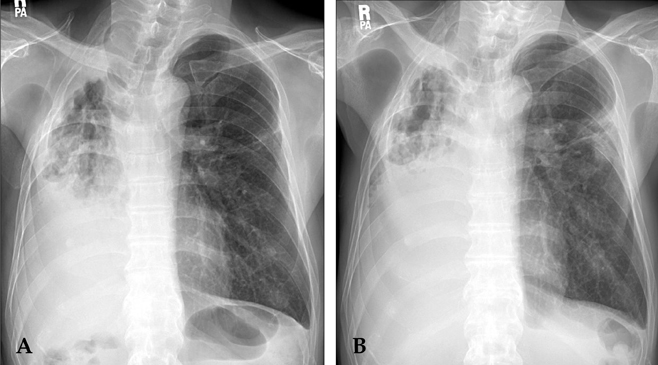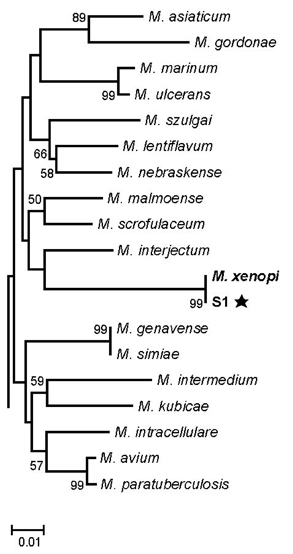Yonsei Med J.
2007 Oct;48(5):871-875. 10.3349/ymj.2007.48.5.871.
Pulmonary Disease Caused by Mycobacterium xenopi: The First Case in Korea
- Affiliations
-
- 1Division of Pulmonary and Critical Care Medicine, Department of Medicine, Samsung Medical Center, Sungkyunkwan University School of Medicine, Seoul, Korea. wjkoh@skku.edu
- 2Department of Laboratory Medicine, Samsung Medical Center, Sungkyunkwan University School of Medicine, Seoul, Korea.
- 3Department of Thoracic Surgery, Samsung Medical Center, Sungkyunkwan University School of Medicine, Seoul, Korea.
- 4Korean Institute of Tuberculosis, Korean National Tuberculosis Association, Seoul, Korea.
- 5Department of Microbiology and Immunology, and Cancer Research Institute, College of Medicine, Seoul National University, Seoul, Korea.
- KMID: 1122628
- DOI: http://doi.org/10.3349/ymj.2007.48.5.871
Abstract
- Mycobacterium xenopi is a nontuberculous mycobacterium (NTM) that rarely causes pulmonary disease in Asia. Here we describe the first case of M. xenopi pulmonary disease in Korea. A 66-year-old man was admitted to our hospital with a 2-month history of productive cough and hemoptysis. His past medical history included pulmonary tuberculosis 44 years earlier, leading to a right upper lobectomy. Chest X-ray upon admission revealed cavitary consolidation involving the entire right lung. Numerous acid-fast bacilli were seen in his initial sputum, and M. xenopi was subsequently identified in more than five sputum cultures, using molecular methods. Despite treatment with clarithromycin, rifampicin, ethambutol, and streptomycin, the infiltrative shadow revealed on chest X-ray increased in size. The patient's condition worsened, and a right completion pneumonectomy was performed. The patient consequently died of respiratory failure on postoperative day 47, secondary to the development of a late bronchopleural fistula. This case serves as a reminder to clinicians that the incidence of NTM infection is increasing in Korea and that unusual NTM are capable of causing disease in non-immunocompromised patients.
Keyword
MeSH Terms
Figure
Cited by 2 articles
-
Surgical Treatment of Pulmonary Diseases Due to Nontuberculous Mycobacteria
Won-Jung Koh, Yee Hyung Kim, O Jung Kwon, Yong Soo Choi, Kwhanmien Kim, Young Mog Shim, Jhingook Kim
J Korean Med Sci. 2008;23(3):397-401. doi: 10.3346/jkms.2008.23.3.397.Successful Treatment of Mycobacterium celatum Pulmonary Disease in an Immunocompetent Patient Using Antimicobacterial Chemotherapy and Combined Pulmonary Resection
Hee-Jung Jun, Nam Yong Lee, Jhingook Kim, Won-Jung Koh
Yonsei Med J. 2010;51(6):980-983. doi: 10.3349/ymj.2010.51.6.980.
Reference
-
1. Diagnosis and treatment of disease caused by nontuberculous mycobacteria. This official statement of the American Thoracic Society was approved by the Board of Directors, March 1997. Medical Section of the American Lung Association. Am J Respir Crit Care Med. 1997. 156:S1–S25.2. Koh WJ, Kwon OJ, Lee KS. Diagnosis and treatment of nontuberculous mycobacterial pulmonary diseases: a Korean perspective. J Korean Med Sci. 2005. 20:913–925.
Article3. Jeon K, Koh WJ, Kwon OJ, Suh GY, Chung MP, Kim H, et al. Recovery rate of NTM from AFB smear-positive sputum specimens at a medical centre in South Korea. Int J Tuberc Lung Dis. 2005. 9:1046–1051.4. Koh WJ, Kwon OJ, Jeon K, Kim TS, Lee KS, Park YK, et al. Clinical significance of nontuberculous mycobacteria isolated from respiratory specimens in Korea. Chest. 2006. 129:341–348.
Article5. Jenkins PA, Campbell IA; Research Committee of The British Thoracic Society. Pulmonary disease caused by Mycobacterium xenopi in HIV-negative patients: five year follow-up of patients receiving standardised treatment. Respir Med. 2003. 97:439–444.
Article6. Parrot RG, Grosset JH. Post-surgical outcome of 57 patients with Mycobacterium xenopi pulmonary infection. Tubercle. 1988. 69:47–55.
Article7. Simor AE, Salit IE, Vellend H. The role of Mycobacterium xenopi in human disease. Am Rev Respir Dis. 1984. 129:435–438.8. Yamazaki Y, Fujiuchi S, Matsumoto H, Takahashi T, Takeda A, Fujita Y, et al. Two cases of pulmonary Mycobacterium xenopi infection. Nihon Kokyuki Gakkai Zasshi. 2003. 41:556–560.9. Kim H, Kim SH, Shim TS, Kim MN, Bai GH, Park YG, et al. PCR restriction fragment length polymorphism analysis (PRA)-algorithm targeting 644 bp Heat Shock Protein 65 (hsp65) gene for differentiation of Mycobacterium spp. J Microbiol Methods. 2005. 62:199–209.
Article10. Kim H, Kim SH, Shim TS, Kim MN, Bai GH, Park YG, et al. Differentiation of Mycobacterium species by analysis of the heat-shock protein 65 gene (hsp65). Int J Syst Evol Microbiol. 2005. 55:1649–1656.
Article11. Falkinham JO 3rd. Epidemiology of infection by nontuberculous mycobacteria. Clin Microbiol Rev. 1996. 9:177–215.
Article12. Smith MJ, Citron KM. Clinical review of pulmonary disease caused by Mycobacterium xenopi. Thorax. 1983. 38:373–377.
Article13. Banks J, Hunter AM, Campbell IA, Jenkins PA, Smith AP. Pulmonary infection with Mycobacterium xenopi: review of treatment and response. Thorax. 1984. 39:376–382.
Article14. Wittram C, Weisbrod GL. Mycobacterium xenopi pulmonary infection: evaluation with CT. J Comput Assist Tomogr. 1998. 22:225–228.15. Contreras MA, Cheung OT, Sanders DE, Goldstein RS. Pulmonary infection with nontuberculous mycobacteria. Am Rev Respir Dis. 1988. 137:149–152.
Article16. Banks J, Jenkins PA. Combined versus single antituberculosis drugs on the in vitro sensitivity patterns of non-tuberculous mycobacteria. Thorax. 1987. 42:838–842.
Article17. Lounis N, Truffot-Pernot C, Bentoucha A, Robert J, Ji B, Grosset J. Efficacies of clarithromycin regimens against Mycobacterium xenopi in mice. Antimicrob Agents Chemother. 2001. 45:3229–3230.
Article18. Majoor CJ, Schreurs AJ, Weers-Pothoff G. Mycobacterium xenopi infection in an immunosuppressed patient with Crohn's disease. Thorax. 2004. 59:631–632.
Article19. Schmitt H, Schnitzler N, Riehl J, Adam G, Sieberth HG, Haase G. Successful treatment of pulmonary Mycobacterium xenopi infection in a natural killer cell-deficient patient with clarithromycin, rifabutin, and sparfloxacin. Clin Infect Dis. 1999. 29:120–124.
Article20. Lang-Lazdunski L, Offredo C, Le Pimpec-Barthes F, Danel C, Dujon A, Riquet M. Pulmonary resection for Mycobacterium xenopi pulmonary infection. Ann Thorac Surg. 2001. 72:1877–1882.
- Full Text Links
- Actions
-
Cited
- CITED
-
- Close
- Share
- Similar articles
-
- Surgical Treatment of Pulmonary Diseases Due to Nontuberculous Mycobacteria
- Acute pneumonia caused by mycobacterium intracellulare
- A Case of Mycobacterium abscessus Lung Disease in a Patient with Cystic Fibrosis
- Diagnosis and Treatment of Nontuberculous Mycobacterial Lung Disease
- Nontuberculous Mycobacterial Lung Disease Caused by Mycobacterium shinjukuense: The First Reported Case in Korea



